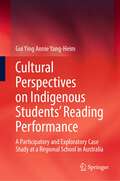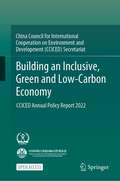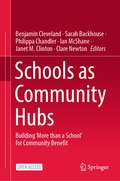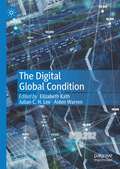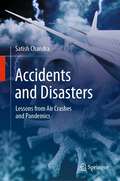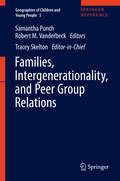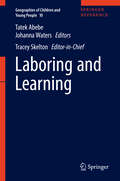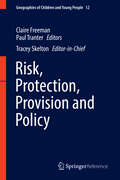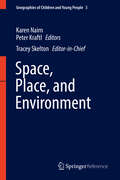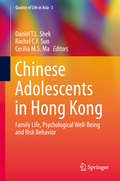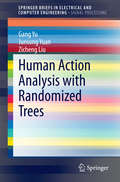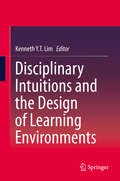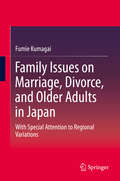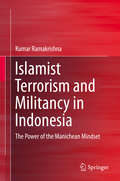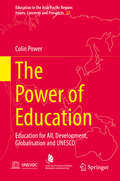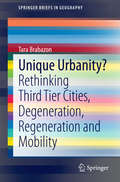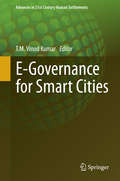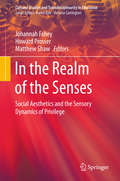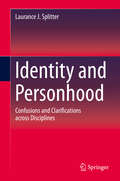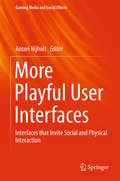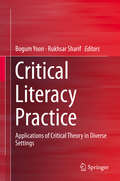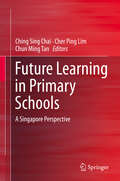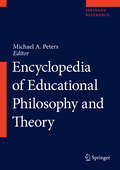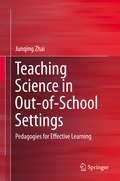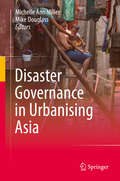- Table View
- List View
Cultural Perspectives on Indigenous Students’ Reading Performance: A Participatory and Exploratory Case Study at a Regional School in Australia
by Gui Ying Yang-HeimThis book explores the contextual, particularly cultural-related, factors that may impact reading outcomes of young Indigenous learners in their early years, underpinned by the conceptual framework of cultural capital originated by Bourdieu. By drawing upon a participatory and exploratory case study, conducted at a regional school in Australia over a period of six months, it highlights the challenges that Indigenous students face in reading, and how the contextual factors contribute to Indigenous students’ development in reading skills and their reading performance. This book helps readers to gain a better and deeper understanding of Indigenous culture, the importance of the role that culture plays in Indigenous children’s literacy education, and how it shapes the way they learn and think.
Building an Inclusive, Green and Low-Carbon Economy: CCICED Annual Policy Report 2022
by CCICEDThis open access book introduces the major environmental green development issues from six major themes carbon neutrality, nature-based solution, watershed management and climate adaptation, BRI green development, sustainable food supply chain, ecosystem-based integrated ocean management focusing on the progress of China’s environment and development policies from 2021 accomplishments. It is based on the research outputs of CCICED in the year of 2021, which marks China’s start point of implementation of its 14th Five-Year Plan when world economy also strived to recover from the pandemic.
Schools as Community Hubs: Building ‘More than a School’ for Community Benefit
by Benjamin Cleveland Sarah Backhouse Philippa Chandler Ian McShane Janet M. Clinton Clare NewtonThis open access book brings together research on the planning, design, governance and management of schools as community hubs—places that support the development of better-connected, more highly integrated, and more resilient communities with education at the centre. It explores opportunities and difficulties associated with bringing schools and communities closer together, with a focus on the facilities needed to accommodate shared experiences that generate social capital and deliver reciprocal benefits.This book discusses the expanded roles of schools, and investigates how schools may offer more to their communities—historically, currently and into the future—with respect to the role of the built environment in situating community activities and services.Organised around four sections, it showcases important areas of development in the field via an interdisciplinary approach, which weaves together empirical research with theoretical insights and practical examples. This book not only highlights the challenges associated with the development of schools as community hubs but offers evidence-based insights into how to overcome such hurdles to develop community-facing schools into the future.
The Digital Global Condition
by Elizabeth Kath Julian C. H. Lee Aiden WarrenThis book explores how globalization and ubiquity of digital technology combine to create specific global impacts, challenges and opportunities. Although globalization is already associated with the speeding up of interactions and change, digital globalization is characterized by immediacy. The utter pervasiveness opens new global vulnerabilities at international, national, social and personal levels. The Digital Global Condition examines the nature of digital globalization, enabling us to not only inhabit a digital world, but also to understand it, even to live well in it.
Accidents and Disasters: Lessons from Air Crashes and Pandemics
by Satish ChandraThis book deals with the contemporary subject of perception of risk and its influence on accidents and disasters. The contents examine the conventional viewpoints on human errors, incubation of errors, complexity and organisational deviance as a cause for accidents. Work of Mary Douglas with regard to risk, Charles Perrow's work on the normal accident theory and Diane Vaughn's theory on normalisation of deviance are examined from a fresh perspective in this book. It also discusses prominent accidents in aviation, space, nuclear energy, automotive and healthcare, using the pandemic and Boeing 737 Max as a backdrop to study accidents and disasters. It further explores the background and similarities to these events and addresses the core issues such as the state of regulation, the worldview of the sociologists, and proposes that mental models of complex systems, avarice and risk for gain as other possibilities for accidents. Using the concept of nudge in behavioural economics and the Elinor Ostrom’s viewpoint on regulating for common good, it suggests a way forward through the High Reliability Organisation Theory (HRO) leading to enhanced risk perception. The book will be of interest to those who would like to understand the need to incorporate risk perception into regulation, engineers and scientists, professionals and policy makers working in the areas of disaster and risk management, technology areas like aviation, nuclear plants, space and healthcare, students of the sociology of risk and of course the general reader.
Families, Intergenerationality, and Peer Group Relations
by Samantha Punch Robert M. Vanderbeck Tracey SkeltonThis volume addresses children and young people’s relationships both within and beyond the context of the family. It begins with familial relationships and the home by examining the social and cultural complexities of families, intimacies and interdependencies, including the dynamics of families as spatial units (nuclear, multi-generational, alternative) and the roles that children play (as carers etc.). In addition to considering child/parent relations, sibling relationships and birth order, the initial section includes particular dimensions of children's familial relationships in diverse contexts, such as family food practices, aspirations and work practices. The second section explores geographical dimensions of adult/child relationships beyond the dynamics of the family and across the lifecourse. It considers the roles that intergenerationality plays in children's and young people's lives as well as their links with wider communities. The section addresses broader conceptual issues and themes (child-adult relationships outside the home; intergenerational geographies and spaces; and the intergenerational city) while also providing more focused discussions of current issues related to the geographies of intergenerationality including adoption, looked after children and fertility. The final section addresses children and young people's relationships with one another: friendship, peer group relations, and sexualities. It explores the geographies and spatialities of affective relations and emotional practices among children and young people. Geographies of bodies and embodiment and their connection to identities is an important part of this section. The chapters range from cross-cultural comparisons of age mixing among children to specific kinds of relationship formations between children and young people (e.g. friendship; sexual relations; gangs; bullying) and the spaces and places (including cyberspace) that facilitate, impede and organise these relationships. The diverse relationships that children and young people form with both one another and with adults have significant geographical dimensions.
Laboring and Learning
by Tatek Abebe Johanna WatersThis volume incorporates ground-breaking new academic perspectives on the contributions that children and young people make to societies around the world, with a particular focus on learning and work. The chapters in the volume offer conceptual and empirical insights into how young people learn to labour, and the complex social, spatial, temporal, institutional and relational processes that informs their engagements in daily, generational and social reproduction. The editors have intentionally avoided using the terms 'education' and 'employment' in the title, as this volume is an attempt to capture the multitude of ways, spaces and contexts (not just 'formal') in which learning takes place and work is carried out. Here, learning indicates education in the broadest possible sense, to incorporate not just formal schooling and the acquisition of institutionally recognised academic knowledge and credentials, but also informal learning (including socialization and the on-the-job acquisition of skills that takes place almost imperceptibly, over time). In addition to the theoretical perspectives this volume brings on young people's education and work, other prominent conceptual themes present throughout the work are mobilities, transitions and gender. Following four initial chapters that engage with conceptual issues, the remainder of the volume is divided into two sections, entitled 'spaces of labouring and learning' and 'livelihoods, transitions and social reproduction'. Within these sections, a broad spectrum of empirical chapters demonstrates how young people live, learn and labour in Africa, Asia, Europe and Latin America. These include, among others, geographies of education; interface between migration, learning and livelihoods; cultural politics of human capital formation; schooling and work; citizenship education; families and parenting; socialization and informal education; education-induced migration; processes and practices of inclusion and exclusion in educational institutions; part-time work; domestic work; care work; informal livelihoods; entrepreneurship; social transitions; and a wide range of social, economic, cultural, political (structural) forces that intersect and dissect these topics. As the reader will become aware, there is no such thing as a standard educational or work trajectory, a 'normal' transition or a straight forward relationship between work, education and social reproduction. Indeed, one of the aims of the volume is deliberately to showcase the diversity that young people's lives hold in this regard.
Risk, Protection, Provision and Policy
by Tracey Skelton Paul Tranter Claire FreemanThe volume provides an overview of recent research (within geography and allied disciplines) around the overarching concept of 'safe and accessible places of encounter'. It develops according to three interrelated themes. The first part of the volume examines several of the many spaces children use and that are relevant to the geographies of children and young people including: the city centre and inner city high rise housing, urban versus suburban and rural spaces, local neighbourhoods, the 'home' (for particular groups of children and young people such as child domestic workers in Bangladesh), school playgrounds, services (such as domestic violence shelters), outdoor natural spaces, and "life space" (where music and arts are presented in a non-political space in Bosnia-Herzegovina). The second part examines how notions of safety, protection and risk relate to providing children and young people with good life chances, and accessible spaces that enhance or reduce well-being. This middle section emphasises the debate about risk and the need to balance risk and safety/protection. The final part focuses on policy that builds on the provision/identification of spaces, safety/protection and risk. The emphasis is on how policy at different levels (international-national-local-family) helps provide better spaces of encounter and enhances life chances for children and young people. This section also recognises the different levels of policy making associated with different parts of the world and different regional settings. The gap between policy intentions and outcomes is recognised (e. g Cambodia's policies on orphanage tourism). The policy section includes contributions that relate to planning, education, migration, architecture, health, connection and citizenship, and sustainability. It provides insights into how professionals working in these fields can, through policy, enhance children's and young people's lived experiences and living environments. p>
Space, Place, and Environment
by Karen Nairn Peter Kraftl Tracey SkeltonThis volume demonstrates the multiple ways that space, place and environment interact with children and young people’s lives. The contributors offer a suite of cutting-edge tools and lively examples for theorising how space, place and environment are (con)figured in children and young people’s lives. They demonstrate how the social borders between childhood and adulthood, and spatial borders between rural and urban, countries, neighbourhoods, and institutions, are relationally produced. The volume is organised into five sections: Indigenous Youth: Space and Place; Children, Nature and Environmental Education; Urban Spaces; Home/less Spaces; and Border Spaces. These themes signal the major issues in cutting-edge children’s geographies scholarship. Diverse geographical contexts are covered in this volume – including Australia, Brazil, Canada, Cyprus, Ecuador, India, Indonesia, Kazakhstan, Mexico, Morocco, New Zealand, Peru, Slovenia, Spain, the United Kingdom and the United States. All of the contributors advocate greater recognition of children and young people’s spatial rights, whether in the home, outdoors, at school, crossing borders, in public and digital spaces, or simply looking for a safe place to sleep. Children and young people’s perspectives on space, place and the environment, and their desire for places to call their own, tie the volume together. The volume is a testament to the politics of the spaces and places of childhood, highlighting how many children and young people face obstacles to living well and to living where they desire.
Chinese Adolescents in Hong Kong: Family Life, Psychological Well-Being and Risk Behavior (Quality of Life in Asia #5)
by Daniel T. L. Shek Rachel C. F. Sun Cecilia M. S. MaThis book documents the findings of a 3-year longitudinal study on the quality of family life, personal well-being and risk behavior in Chinese adolescents in Hong Kong. It presents the profiles of quality of family life (family functioning, parental behavioral control, parental psychological control and parent-child relational qualities); personal well-being (positive youth development and life satisfaction measures) and adolescent risk behavior (substance abuse, delinquency, self-harm and suicidal behavior and behavioral intentions to engage in risk behavior) in different adolescent populations across time. It also examines theoretical issues concerning the interrelationships between family quality of life, psychological well-being and risk behavior in adolescents. Practically speaking, the findings can help youth workers appreciate the importance of family quality of life and positive youth development in shaping the personal well-being and risk behavior in Chinese adolescents in Hong Kong.
Human Action Analysis with Randomized Trees
by Gang Yu Junsong Yuan Zicheng LiuThis book will provide a comprehensive overview on human action analysis with randomized trees. It will cover both the supervised random trees and the unsupervised random trees. When there are sufficient amount of labeled data available, supervised random trees provides a fast method for space-time interest point matching. When labeled data is minimal as in the case of example-based action search, unsupervised random trees is used to leverage the unlabelled data. We describe how the randomized trees can be used for action classification, action detection, action search, and action prediction. We will also describe techniques for space-time action localization including branch-and-bound sub-volume search and propagative Hough voting.
Disciplinary Intuitions and the Design of Learning Environments
by Kenneth Y. T. LimMany of the chapters within draw frequent and explicit linkages to curriculum design, from the premise of the need to go beyond addressing the conceptions of learners, to seeking to understand the substrate upon which these conceptions are founded. The argument is made that this substrate comprises the particular set of lived experiences of each learner, and how - because these lived experiences are as tacit as they are diverse - designing curriculum around misconceptions and preconceptions alone would not lead to enduring understanding from first principles. From this perspective, Disciplinary Intuitions constitute an exciting field at the nexus of learning theories and curriculum design.
Family Issues on Marriage, Divorce, and Older Adults in Japan
by Fumie KumagaiThis book provides insightful sociological analyses of Japanese demography and families, paying attention not only to national average data, but also to regional variations and community level analyses. In analyzing Japanese family issues such as demographic changes, courtship and marriage, international marriage, divorce, late-life divorce, and the elderly living alone, this book emphasizes the significance of two theoretical frameworks: the dual structure and regional variations of the community network in Japan. By emphasizing the extensive cultural diversity from one region to another, this book represents a paradigm shift from former studies of Japanese families, which relied mostly on national average data. The method of analysis adopted in the study is qualitative, with a historical perspective. The book is thus an invitation to more in-depth, qualitative dialogue in the field of family sociology in Japan. This book will be of great interest not only to Asian scholars, but also to other specialists in comparative family studies around the world.
Islamist Terrorism and Militancy in Indonesia
by Kumar RamakrishnaDrawing upon insights from the natural and social sciences, this book puts forth a provocative new argument that the violent Islamist threat in Indonesia today derives its stubborn resilience from being in essence a complex, adaptive and self-organizing system - or what some specialists might even call a super-organism. The book challenges the popular assumption that ideology is the root cause that explains why Indonesian Islamists radicalize into violent extremism. In addition it addresses why despite years of intense security force pressure, seemingly disparate militant cells keep 'popping up' like the proverbial hydra - and in the apparent absence of a centralized coordinating body, nevertheless appear to display an organic interconnectivity with one another. Going beyond standard ideological mantras the book argues that fresh inter-disciplinary thinking is needed to cope with the constantly mutating violent Islamist challenge in Indonesia, and puts forth a comprehensive strategy for doing so. It will be of interest to academics and students of terrorism, religion and violence in the Southeast Asian region.
The Power of Education
by Colin PowerThis book is about the power of education: the kind of education that simultaneously improves the quality of life both of individuals and the wider society. It explains why education must be viewed as a basic human right, as a value in and of itself, and reviews the evidence on how education builds the human resources that individuals and nations need to be productive, to continue to learn, to solve problems, to be creative, and to live together and with nature in peace and harmony. When nations ensure that such an education is accessible to all throughout their lives, education becomes the engine of sustainable development - economic, social, moral and cultural. The book is unique in that it covers the development of education at all levels in all countries of the Asia-Pacific region and beyond, using the latest international data bases, while blending in analyses of both quantitate and qualitative research.
Unique Urbanity?
by Tara BrabazonThis book investigates small cities - cities and towns that are not well known or internationally branded, but are facing structural economic and social issues after the Global Financial Crisis. They need to invent, develop and manage new reasons for their existence. The strengths and opportunities are often underplayed when compared to larger cities. These small cities do not have the profile of New York, London, Tokyo or Cairo, or second-tier cities like San Francisco, Manchester, Osaka or Alexandria. This book traces the current state of the creative industries literature after the GFC, but with a specific focus. The specific - and worsening - conditions in third-tier cities are logged. The social and economic challenges within these regions are great, particularly with regard to health and health services, education, employment, social mobility and physical activity. This is not a study that merely diagnoses problems but raises strategies for third-tier cities to create both a profile and growth. The current research field is synthesized to reveal how cities are defined, constituted, developed and, in many cases, suffering decline. There is an imperative to build relationships with other urban environments. The book enters these under-discussed locations and reveal the scarred layering of injustice, signified by depopulation, dis-investment, economic decline and a reduction in public services for health, transportation and education, while also developing specific and innovative models for improvement. The vista summoned in Unique Urbanity is international, with strong attention to trans-local strategies that offer wide relevance, currency and opportunities for policy makers. While third-tier cities are often hidden, marginalized, invisible or demeaned, Unique Urbanity shows that innovation, imagination and creativity can emerge in small places.
E-Governance for Smart Cities
by T. M. Vinod KumarThis book highlights the electronic governance in a smart city through case studies of cities located in many countries. "E-Government" refers to the use by government agencies of information technologies (such as Wide Area Networks, the Internet, and mobile computing) that have the ability to transform relations with citizens, businesses, and other arms of government. These technologies can serve a variety of different ends: better delivery of government services to citizens, improved interactions with business and industry, citizen empowerment through access to information, or more efficient government management. The resulting benefits are less corruption, increased transparency, greater convenience, revenue growth, and/or cost reductions. The book is divided into three parts. * E-Governance State of the Art Studies of many cities * E-Governance Domains Studies * E-Governance Tools and Issues
In the Realm of the Senses
by Johannah Fahey Howard Prosser Matthew ShawThis book charts new territory both theoretically and methodologically. Drawing on MacDougall's notion of social aesthetics, it explores the sensory dimensions of privilege through a global ethnography of elite schools. The various contributors to the volume draw on a range of theoretical perspectives from Lefebvre, Benjamin, Bourdieu, Appadurai, Kress and van Leeuwen to both broaden and critique MacDougall's original concept. They argue that within these elite schools there is a relationship between their 'complex sensory and aesthetic environments' and the construction of privilege within and beyond the school gates. Understanding the importance of the visual to ethnography, the social aesthetics of these elite schools are captured through the inclusion of a series of visual essays that complement the written accounts of the aesthetics of privilege. The collection also includes a series of vignettes that further explore the sensory dimension of these aesthetics: touch, taste--though metaphorically understood-- sight and sound. These varying formats illustrate the aesthetic nature of social relations and the various ways in which class permeates the senses. The images from across the different schools and their surroundings immerse the reader in these worlds and provide poignant ethnographic data of the forces of globalisation within the context of elite schooling.
Identity and Personhood
by Laurance J. SplitterThis book approaches the concept of identity from both logical-linguistic and socio-cultural perspectives, and explores its implications for our understanding of who or what we persons really are. In the process, it bridges disciplines that often remain disconnected - most notably analytic philosophy and the social sciences - and offers a novel critique of citizenship and moral education, "identity politics", and other contemporary domains of inquiry. Although the book has a multi-disciplinary focus, it is philosophical in its overall orientation (but accessible to readers from outside philosophy) and educational in its mission (but of interest to readers who are not formally educators). Chapters 2-5 discuss the philosophical and (where appropriate) scientific dimensions of identity, chapters 6-7 explore its socio-cultural dimensions and chapter 8 examines its educational dimensions and implications. The book will be of particular interest to those researching or teaching civics, citizenship education and moral education, as well as those involved in cultural, political and religious studies in a broader sense. It will also appeal to anyone who finds him- or herself wondering about the state of the world in the Twenty-First Century, and who suspects that rethinking what it means to be a person in that world might not be a bad idea.
More Playful User Interfaces
by Anton NijholtThis book covers the latest advances in playful user interfaces - interfaces that invite social and physical interaction. These new developments include the use of audio, visual, tactile and physiological sensors to monitor, provide feedback and anticipate the behavior of human users. The decreasing cost of sensor and actuator technology makes it possible to integrate physical behavior information in human-computer interactions. This leads to many new entertainment and game applications that allow or require social and physical interaction in sensor- and actuator-equipped smart environments. The topics discussed include: human-nature interaction, human-animal interaction and the interaction with tangibles that are naturally integrated in our smart environments. Digitally supported remote audience participation in artistic or sport events is also discussed. One important theme that emerges throughout the book is the involvement of users in the digital-entertainment design process or even design and implementation of interactive entertainment by users themselves, including children doing so in educational settings.
Critical Literacy Practice: Applications of Critical Theory in Diverse Settings
by Bogum Yoon Rukhsar SharifThis edited book shows how critical literacy can be applied in and outside the classroom setting. It shows educators how critical theory is applied in practice using studies in diverse K-16 settings, kindergarten through university contexts. By providing specific examples of critical literacy practice in the classroom and beyond, the book aims to help teachers, researchers and teacher educators make clear connections between theory and practice in critical literacy.
Future Learning in Primary Schools
by Ching Sing Chai Cher Ping Lim Chun Ming TanThis edited book tells the story of the multifaceted efforts devoted by a "future school" in Singapore--The Nan Chiau Primary School--in shaping future learning. It documents the various measures implemented by one primary school to improve student learning outcomes in a technology-rich teaching and learning environment. With the current interest in Singapore's "Masterplan for ICT (information and communication technology) in Education," and the increasing focus on teaching and learning design by leading education researchers and professionals, this well-timed book will appeal to policy makers, educators and researchers.
Encyclopedia of Educational Philosophy and Theory
by Michael A. PetersThis encyclopaedia is a dynamic reference and study place for students, teachers, researchers and professionals in the field of education, philosophy and social sciences, offering both short and long entries on topics of theoretical and practical interest in educational theory and philosophy by authoritative world scholars representing the full ambit of education as a rapidly expanding global field of knowledge and expertise. This is an encyclopaedia that is truly global and while focused mainly on the Western tradition is also respectful and representative of other knowledge traditions. It professes to understand the globalization of knowledge. It is unique in the sense that it is based on theoretical orientations and approaches to the main concepts and theories in education, drawing on the range of disciplines in the social sciences. The encyclopaedia privileges the "theory of practice", recognizing that education as a discipline and activity is mainly a set of professional practices that inherently involves questions of power and expertise for the transmission, socialization and critical debate of competing norms and values.
Teaching Science in Out-of-School Settings
by Junqing ZhaiThis book explores pedagogical approaches used by informal science educators and botanic garden educators in particular, when teaching science to visiting students (7-12 years old). More specifically, it draws on the sociocultural perspective of learning, and highlights the importance of discourse in learning processes. It examines the interactions between four botanic garden educators (BGEs) and their students, focusing on how the students' contributions to the talk are followed up on by the BGEs. Moreover, it includes an investigation into which kinds of teaching behaviours on the part of BGEs can best support learning.
Disaster Governance in Urbanising Asia
by Michelle Ann Miller Mike DouglassThis edited book approaches the threat and impact of environmental disasters on Asia's urban populations from a governance perspective. It adopts a multi-sector and multi-disciplinary approach to disaster governance that emphasises the importance of multiple stakeholders in preparing for, responding to and recovering from disasters and their cascading impacts in Asia's cities. The contributors to this volume take a broad view of the multifaceted causalities and the interconnected threats and vulnerabilities of environmental disasters in urbanising Asia. As such, the book is an invitation to advance scholarship in the search for more effective, comprehensive and inclusive disaster preparedness agendas, recovery programs and development priorities.
